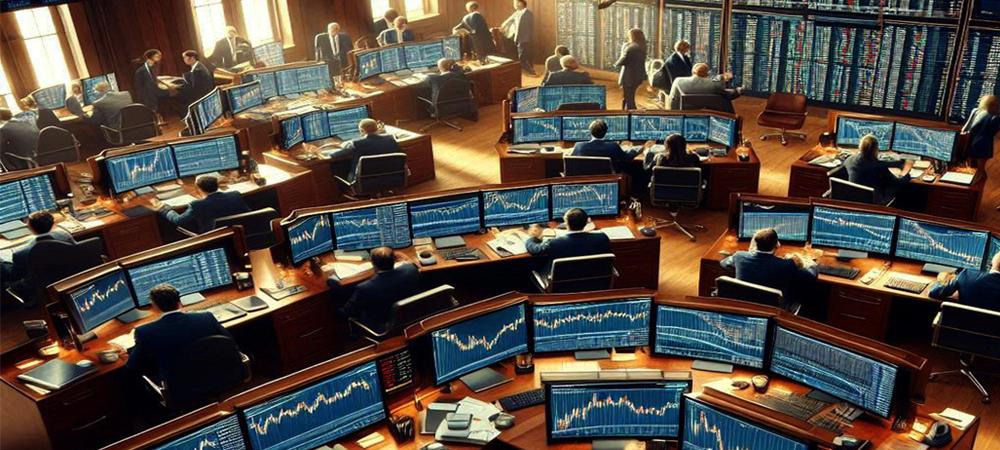Who’s on the Other Side of Your Screen?

Uncover the Hidden Players Driving the Market
When you trade, you're not just looking at charts or price movements. Every trade you make is part of a much larger, more complex system driven by powerful market participants. Understanding who these players are and how they impact the market can give you the edge in your trading. Let's break down the key players:
1. Institutional Investors
These are large financial organizations, such as hedge funds, investment banks, pension funds, and insurance companies. Institutional investors control trillions of dollars and often account for a major portion of daily trading volume. They typically trade on a much larger scale, using sophisticated tools, research, and algorithms to make decisions. Their trades tend to be based on long-term strat-egies, and their actions can have significant impacts on market prices, especially during news re-leases or major economic events.
- They control a massive amount of capital.
- Their trades are often planned and based on long-term strategies.
- They can cause significant price movements, especially in illiquid markets.
2. Central Banks and Governments
Central banks (like the Federal Reserve, the European Central Bank, and the Bank of Japan) and governments play a crucial role in the forex and commodities markets. They influence currency and commodity prices through monetary policies (such as interest rate decisions and bond purchas-es) and fiscal policies (such as government spending). Their actions can lead to large, sudden price movements.
For example, when a central bank raises or lowers interest rates, it can cause an immediate shift in currency prices. Likewise, government interventions—such as economic stimulus packages or trade policies—can significantly affect markets.
- Central banks control monetary policy, which directly impacts currency prices.
- Government policies and interventions can lead to rapid market movements.
- Forex traders and commodity traders closely watch these announcements for opportunities.
3. Market Makers
Market makers are typically large financial institutions or brokers that provide liquidity to the mar-ket by offering to buy and sell at specific prices. They help facilitate trades, ensuring that you can enter or exit positions without significant slippage (the difference between the expected price and the actual price).
In some cases, market makers can also influence price movement, particularly in less liquid mar-kets. They often have access to advanced trading algorithms and real-time data that allows them to move large amounts of capital without causing visible price changes at first.
- Market makers ensure liquidity and smooth market operations.
- They provide the buy and sell prices you see on your chart.
- In certain market conditions, they can play a role in setting price levels.
4. Retail Traders (Like You)
Retail traders, who make up the vast majority of market participants, often trade using their own capital through online brokers. Unlike institutional players, retail traders typically have smaller accounts and may trade based on short-term price movements, technical indicators, or news. Alt-hough retail traders alone don’t have the power to move the market, collectively they can have an impact, especially in times of high volatility.
Retail traders often react to market movements made by institutional investors or central banks. Their trades are influenced by emotions, news, and market sentiment, which can create short-term opportunities.
Understanding Market Dynamics and Positioning Yourself for Success
Now that you know the key players in the market, it's important to understand that you, as a retail trader, are not alone. You're trading in an environment where massive institutional investors, government decisions, and advanced algorithms are influencing price movements.
Here’s how you can position yourself:
- Trade with Patience and Discipline: Instead of trying to "beat" the market, align your strategy with the flow of the market. Be patient, and wait for the right setups—don't chase the market.
- Understand Market Sentiment: The actions of larger players like institutional investors can cause trends and major price shifts. By understanding the broader sentiment and key news events, you can better anticipate price movements.
- Stay Informed: Pay attention to news, central bank policies, and global events. These can have an immediate effect on the market. For example, interest rate decisions, economic re-ports, or geopolitical events can lead to sharp price movements in a very short time.
- Risk Management is Key: With larger players in the market, there will always be volatili-ty. Protect your capital by setting clear risk parameters. Use stop-losses, diversify your trades, and don't over-leverage your positions.
- Trade Smart, Not Fast: The market isn’t a race. Institutional players move large amounts of capital, and they can make decisions based on solid analysis, not emotions. Instead of trying to outsmart them, trade with a clear strategy, a disciplined mindset, and an eye on long-term growth.
The Bottom Line:
You’re not just trading with the market—you're trading alongside these massive, influential players who are shaping the price movements every day. To succeed, you must understand their impact, align yourself with the bigger market forces, and focus on long-term strategies. This isn’t about beating the market, but about being smart, disciplined, and patient in your approach.
By learning how the market really works, you’ll be able to make better, more informed decisions and avoid chasing the market’s every move. Remember: You’re a part of this global market, but the real success lies in trading with understanding, not against it.